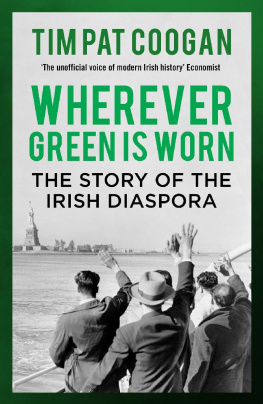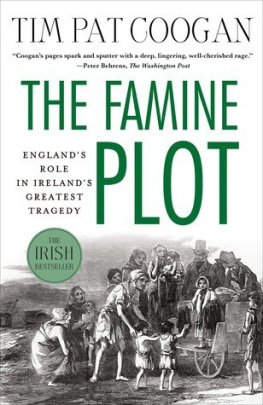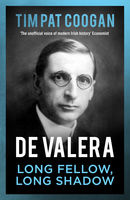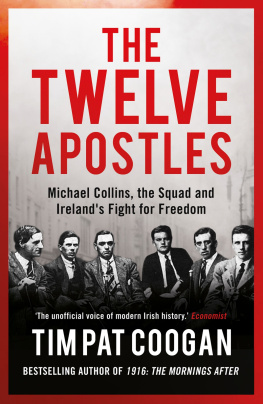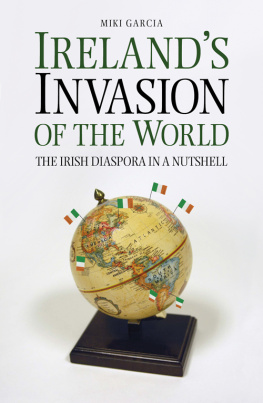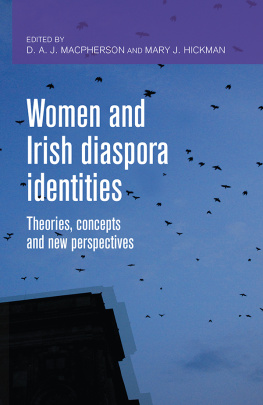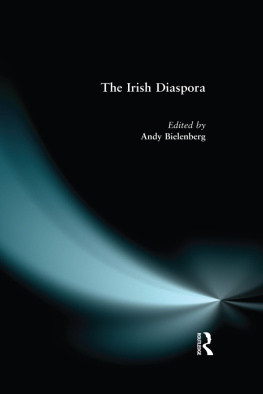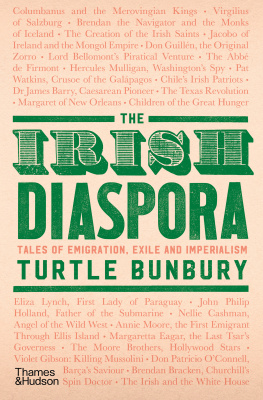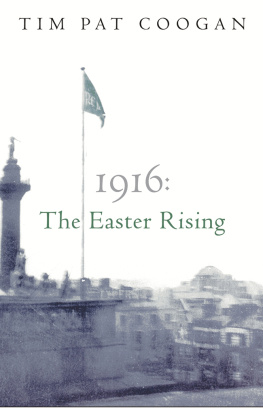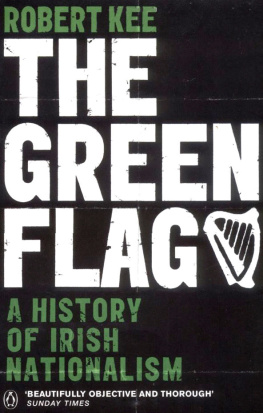Tim Pat Coogan - Wherever Green Is Worn: The Story of the Irish Diaspora
Here you can read online Tim Pat Coogan - Wherever Green Is Worn: The Story of the Irish Diaspora full text of the book (entire story) in english for free. Download pdf and epub, get meaning, cover and reviews about this ebook. year: 2015, publisher: Head of Zeus Ltd, genre: Art. Description of the work, (preface) as well as reviews are available. Best literature library LitArk.com created for fans of good reading and offers a wide selection of genres:
Romance novel
Science fiction
Adventure
Detective
Science
History
Home and family
Prose
Art
Politics
Computer
Non-fiction
Religion
Business
Children
Humor
Choose a favorite category and find really read worthwhile books. Enjoy immersion in the world of imagination, feel the emotions of the characters or learn something new for yourself, make an fascinating discovery.
- Book:Wherever Green Is Worn: The Story of the Irish Diaspora
- Author:
- Publisher:Head of Zeus Ltd
- Genre:
- Year:2015
- Rating:5 / 5
- Favourites:Add to favourites
- Your mark:
- 100
- 1
- 2
- 3
- 4
- 5
Wherever Green Is Worn: The Story of the Irish Diaspora: summary, description and annotation
We offer to read an annotation, description, summary or preface (depends on what the author of the book "Wherever Green Is Worn: The Story of the Irish Diaspora" wrote himself). If you haven't found the necessary information about the book — write in the comments, we will try to find it.
Wherever Green Is Worn: The Story of the Irish Diaspora — read online for free the complete book (whole text) full work
Below is the text of the book, divided by pages. System saving the place of the last page read, allows you to conveniently read the book "Wherever Green Is Worn: The Story of the Irish Diaspora" online for free, without having to search again every time where you left off. Put a bookmark, and you can go to the page where you finished reading at any time.
Font size:
Interval:
Bookmark:



www.headofzeus.com
To the achievements of the Irish, and may reverence never descend upon us
Arthur OShaughnessy
We are the music-makers,
And we are the dreamers of dreams,
Wandering by lone sea-breakers,
And sitting by desolate streams:
World-losers and world-forsakers,
On whom the pale moon gleams:
Yet we are the movers and shakers
Of the world for ever, it seems.
With wonderful deathless ditties
We build up the worlds great cities,
And out of a fabulous story
We fashion an empires glory:
One man with a dream, at pleasure,
Shall go forth and conquer a crown;
And three with a new songs measure
Can trample an empire down.
We, in the ages lying
In the buried past of the earth,
Built Nineveh with our sighing,
And Babel itself with our mirth;
And oerthrew them with prophesying
To the old of the new worlds worth;
For each age is a dream that is dying,
Or one that is coming to birth.
My aim in this work has been to try to explain why the Irish left Ireland in such numbers, where they went, what triumphs or disasters befell them and, by interviewing representative members of the contemporary diaspora, to tell in their own words how the Irish are faring now. So far as I know, no book of a similar scale to this has ever been attempted. I have travelled extensively in Africa, America, Argentina, Asia, Australia, Canada, the Caribbean and Europe, and yet there are vast areas of the world still unreported India, China, Russia I would have attempted these had the publishers deadlines allowed. They remain for another book or another writer. Any of the countries mentioned, to say nothing of the continents, are more than worthy of a book in their own right.
The canvas is so huge that no one book could attempt to describe fully the great outpouring. I have only been able to paint with broad brushstrokes, but I hope that an authentic picture of an important subject has resulted; that I have managed to give a broad general portrait, enlivened by some human, anecdotal detail, of the astonishing story of how a small island, behind an island far out in the Western Atlantic, beyond Europes rim, added significant enrichment to the human experience. Some 70 million people on the globe are entitled to call themselves Irish a remarkable statistic when one considers that there are only five million people on the island of Ireland itself, and of these at least 800,000 living in North-Eastern Ireland say they are not Irish at all and describe themselves as British!
As will become apparent in succeeding pages, the Irish diaspora is the outworking of two forms of colonialism, those of Mother England and Mother Church. I have been interested since boyhood in what was then known not as the diaspora, but as emigration. Like nearly every other Irish person of my generation, some of my closest relatives were forced into unwilling emigration. I have always lived near Dun Laoghaire where the mailboat left for Holyhead, in Wales, and the sight of the shabby, set-faced horde pouring down Marine Road and on to those uncomfortable, vomit-producing ferries for dead-end jobs, punctuated by pub and prejudice, was one of the haunting memories of childhood. Nobody talked about those people, nobody did anything for them. Theirs was a fate that did not speak its name except, from time to time, when drunkenness or fighting caught the attention of the papers. Then there would be head-shakings and comments along the lines of: Isnt it terrible to think of them letting down the country? Denial was all where the emigrants were concerned. Though a certain degree of acknowledgement did grow over the years, it was along the lines indicated by Sean Dunne (195697) in his poem Letter from Ireland:
The country wears their going like a scar,
Today their relatives save to support and
Send others in planes
For the new diaspora
As I grew older and travelled, my imagination was seized by the extent of the Irish population in the world outside Ireland and the variety of conditions in which it lived. The number of people I have bumped into in different parts of the globe who either lived near me or went to school with me or my daughters and increasingly grand-daughters brought home to me in simple fashion the scale of the outpouring. I have never lived more than a couple of miles from where I was born in County Dublin. Yet if one were to make a sort of statistical template designed to cover the whole country, based on my own experience of meeting the Irish abroad, then the scale of the haemorrhage becomes apparent, the origin of that figure of 70 million understandable. The idea of writing a book took hold in the 1980s. My circumstances had changed. I wanted to travel, and I wanted a change from writing about the Northern Troubles and Irish historical topics.
I planned to go after my book on Michael Collins was published in October 1990. However, fortunately or unfortunately it was an instant success, and my publishers thought that my next work should be a biography of his arch rival, de Valera, with the diaspora book following. Then, the twenty-fifth anniversary of the coming of British soldiers to Northern Ireland during the current phase of Anglo-Irish hostilities loomed in 1995, and the publishers again persuaded me that my next work should be a book spanning the history of the Troubles. This appeared in the autumn of 1995. Tours and book signings occupied me until Christmas. I managed some preliminary reading and contact-making, and finally took off to circumnavigate the globe in February 1996, the day after the IRA ended their ceasefire with a bomb in Canary Wharf, London.
It was a terrible, but in a way, appropriate, backdrop because so much of the Irish diasporas view of themselves and of their nationality is coloured by the happenings in Northern Ireland. So many ideas of Irish identity have been formed by, with or from Britain. Particularly in England, so much of the good or bad the Irish do is viewed, often unconsciously, against a horrific historical backdrop. In America, much of the consciousness of being Irish was awakened by the Troubles. The same is true, although with less political effect, of the Irish in other parts of the globe:
Abroad, the history of Irish emigration is one of the success stories of the world. Dispossessed and ravaged by war, famine and centuries of economic decline, the Irish nevertheless managed to battle their way to pinnacles of political and economic success, epitomised by the entry to the White House of John Fitzgerald Kennedy, the descendant of a Famine emigrant from County Wexford. Success was not achieved without great suffering and loss, both in terms of life and human happiness. For some, the dream was never realised and they died nightmarish deaths: on the battlefields of Europe; in the coffin ships in which they fled the Famine; digging canals in the toxic swamps of New Orleans; or of alcoholism in the lonely doss-houses of the British Midlands. Some, however, not only hung on to the lower rungs of the ladder of achievement, but battled their way to the top in the arts, the churches, finance, politics and the armies and navies of the world.
At home, the performance of the so-called Celtic Tiger has resulted in a situation where there is net immigration into Ireland and Irish officials go abroad seeking to persuade Irish emigrants or the descendants of Irish emigrants, to return to Ireland to take up the increasing number of jobs available. As this is being written an item on RTE news is describing how a jobs fair in St Johns, Newfoundland, funded by the Irish jobs agency FAS, attracted 5,000 applicants. The next Census is due in the year 2001, and is expected to show a small but significant increase in the population of the Irish republic literally, a historic turnaround. Sadly however, economic and political conditions in Northern Ireland have dictated that the troubled six North-Eastern counties of contention are still haemorrhaging their best asset their young people. Young Protestants in particular are taking the emigrant route. As the statistical profile of the elderly is also high 35 per cent of the largest Protestant sect, the Presbyterians, are over seventy-five this is an ominous portent for the once dominant Protestant and Unionist people. It would not be the least of the hoped-for dividends if the Peace Process would enable this young, energetic, hard-working component of the Irish family to stay at home.
Font size:
Interval:
Bookmark:
Similar books «Wherever Green Is Worn: The Story of the Irish Diaspora»
Look at similar books to Wherever Green Is Worn: The Story of the Irish Diaspora. We have selected literature similar in name and meaning in the hope of providing readers with more options to find new, interesting, not yet read works.
Discussion, reviews of the book Wherever Green Is Worn: The Story of the Irish Diaspora and just readers' own opinions. Leave your comments, write what you think about the work, its meaning or the main characters. Specify what exactly you liked and what you didn't like, and why you think so.

